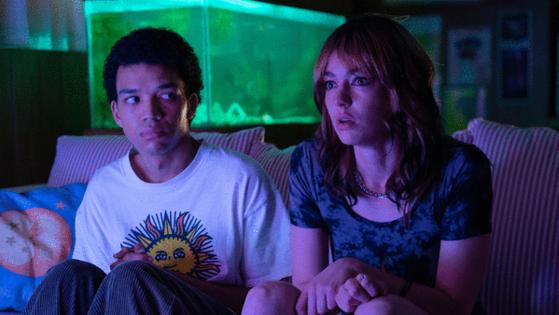Review: 'I Saw the TV Glow' an opaque story of identity, cult fandom
Published in Entertainment News
Writer-director Jane Schoenbrun uses a 1990s-set tale of cult TV obsession to tell a larger story of trans dysphoria in "I Saw the TV Glow," an obtuse psychological drama awash in feelings of alienation and misunderstanding — some part of the story, some not.
Owen, played by Justice Smith (save for a sliver of the story when, as a youngster, he's played by Ian Foreman), is an outcast in generic suburbia in 1996, a time of great melancholy and infinite sadness for American teenagers. (The Smashing Pumpkins' "Tonight, Tonight" and its Georges Méliès-inspired music video plays a role here.)
Owen is curious about "The Pink Opaque," a teen TV show which is like a cross between "Buffy the Vampire Slayer" and "Are You Afraid of the Dark?" with a dash of "Twin Peaks" thrown in for good measure. He can't watch the show at home, in part because his father (played by Limp Bizkit's Fred Durst) dismisses it as "for girls," so he befriends fellow loner Maddy (Brigette Lundy-Paine), whom he spots at school reading a book about the show. They watch it together one night at Maddy's house, and Maddy videotapes future episodes and leaves them for him at school.
Owen and Maddy bond over the show, as well as their shared feeling of outsiderdom, which is where "TV Glow's" subtext becomes text. When Maddy, who is queer, inquires whether Owen likes boys or girls, the detached Owen answers, "I think that I like TV shows." He's not quite sure because he's still trying to figure out the answer, and himself.
"TV Glow" is set in the world of pre-internet adolescence, and takes cues from the way fandom can inform one's own sense of self, especially at a time when you're trying to figure out your place in the world. It is also about trans identity; Schoenbrun ("We're All Going to the World's Fair") is trans, which is key to understanding the film's message and the way it unfolds.
Schoenbrun hones in on their own sense of style while paying homage to weirdo genius auteurs David Lynch and David Cronenberg, and the body horror elements add another layer of meaning to the main allegory.
But as mood and vibe overtake plot and story, the feeling "I Saw the TV Glow" evokes is often stiff and expressionless, even as its visuals are drenched in intoxicating neon blues and greens. The pieces are never all there, and are often at odds with each other. Smith's performance, meanwhile, comes off as grating and uneven, which may be partially by design, but it can make for deeply frustrating viewing.
"I Saw the TV Glow" never shows all its cards, but it does contain a warning about romanticizing the things we were once heavily invested in, and how time shifts our perspectives on the properties over which we once obsessed. It's the movie's best trick, showing how as warm and glowing as nostalgia can be, sometimes it's better left in the past.
_______
'I SAW THE TV GLOW'
Grade: C+
MPA rating: PG-13 (for violent content, some sexual material, thematic elements and teen smoking)
Running time: 1:40
Where to watch: in theaters
_______
©2024 www.detroitnews.com. Visit at detroitnews.com. Distributed by Tribune Content Agency, LLC.







Comments